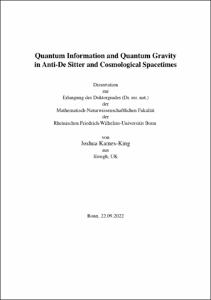Kames-King, Joshua: Quantum Information and Quantum Gravity in Anti-De Sitter and Cosmological Spacetimes. - Bonn, 2022. - Dissertation, Rheinische Friedrich-Wilhelms-Universität Bonn.
Online-Ausgabe in bonndoc: https://nbn-resolving.org/urn:nbn:de:hbz:5-68235
Online-Ausgabe in bonndoc: https://nbn-resolving.org/urn:nbn:de:hbz:5-68235
@phdthesis{handle:20.500.11811/10323,
urn: https://nbn-resolving.org/urn:nbn:de:hbz:5-68235,
author = {{Joshua Kames-King}},
title = {Quantum Information and Quantum Gravity in Anti-De Sitter and Cosmological Spacetimes},
school = {Rheinische Friedrich-Wilhelms-Universität Bonn},
year = 2022,
month = sep,
note = {The holographic principle constitutes a guiding principle for the construction of a quantum theory of gravity. While the final goal is the application of such a theory to our own universe, the most concrete instantiation of the holographic principle derives from string theory on Anti-de Sitter (AdS) spacetimes: the AdS/CFT correspondence. It is this framework with which most of this thesis is concerned. In the first part of this work we consider a supersymmetric extension of a prominent two-dimensional duality: JT gravity on AdS2 and the SYK model. We first demonstrate that the derivation of the Schwarzian boundary action may be generalised to the N = (2) super-Schwarzian. We show that the analysis of low-energy modes on a 1/4 BPS background on AdS4 reduces to the calculation of matter coupled to the super-Schwarzian as determined from N = (2, 2) JT supergravity. We continue in the framework of JT gravity. More specifically we consider a duality between JT gravity on hyperbolic Riemann surfaces (with an arbitrary number of genera and asymptotic boundaries) and the genus expansion of a specific double-scaled matrix integral. In the language of topological gravity we show how the theory may be generalised to arbitrary deformations and how such deformations affect the spectral form factor. We then move on to the analysis of a specific quantum information quantity in the context of the AdS/CFT correspondence: complexity. We demonstrate that the universal Lloyd’s bound, an upper bound on information processing, implies that complexity as a holographic probe may not penetrate behind the inner horizon of a charged black hole. Moreover, we also show how to define complexity non-perturbatively via a replica trick in JT gravity. This resolves an issue regarding the dangerous late time growth of the variance of complexity.
Finally, we move on to considering a toy model both of our past inflationary universe and our dark energy dominated current universe: de Sitter spacetime. In this context we show that for a specific state, the Unruh-de Sitter state, which is analagous to black hole evaporation for a cosmological spacetime, the past cosmological horizon becomes a holographic screen. Furthermore, we calculate the fine-grained entropy showing that information may not be recovered.},
url = {https://hdl.handle.net/20.500.11811/10323}
}
urn: https://nbn-resolving.org/urn:nbn:de:hbz:5-68235,
author = {{Joshua Kames-King}},
title = {Quantum Information and Quantum Gravity in Anti-De Sitter and Cosmological Spacetimes},
school = {Rheinische Friedrich-Wilhelms-Universität Bonn},
year = 2022,
month = sep,
note = {The holographic principle constitutes a guiding principle for the construction of a quantum theory of gravity. While the final goal is the application of such a theory to our own universe, the most concrete instantiation of the holographic principle derives from string theory on Anti-de Sitter (AdS) spacetimes: the AdS/CFT correspondence. It is this framework with which most of this thesis is concerned. In the first part of this work we consider a supersymmetric extension of a prominent two-dimensional duality: JT gravity on AdS2 and the SYK model. We first demonstrate that the derivation of the Schwarzian boundary action may be generalised to the N = (2) super-Schwarzian. We show that the analysis of low-energy modes on a 1/4 BPS background on AdS4 reduces to the calculation of matter coupled to the super-Schwarzian as determined from N = (2, 2) JT supergravity. We continue in the framework of JT gravity. More specifically we consider a duality between JT gravity on hyperbolic Riemann surfaces (with an arbitrary number of genera and asymptotic boundaries) and the genus expansion of a specific double-scaled matrix integral. In the language of topological gravity we show how the theory may be generalised to arbitrary deformations and how such deformations affect the spectral form factor. We then move on to the analysis of a specific quantum information quantity in the context of the AdS/CFT correspondence: complexity. We demonstrate that the universal Lloyd’s bound, an upper bound on information processing, implies that complexity as a holographic probe may not penetrate behind the inner horizon of a charged black hole. Moreover, we also show how to define complexity non-perturbatively via a replica trick in JT gravity. This resolves an issue regarding the dangerous late time growth of the variance of complexity.
Finally, we move on to considering a toy model both of our past inflationary universe and our dark energy dominated current universe: de Sitter spacetime. In this context we show that for a specific state, the Unruh-de Sitter state, which is analagous to black hole evaporation for a cosmological spacetime, the past cosmological horizon becomes a holographic screen. Furthermore, we calculate the fine-grained entropy showing that information may not be recovered.},
url = {https://hdl.handle.net/20.500.11811/10323}
}






